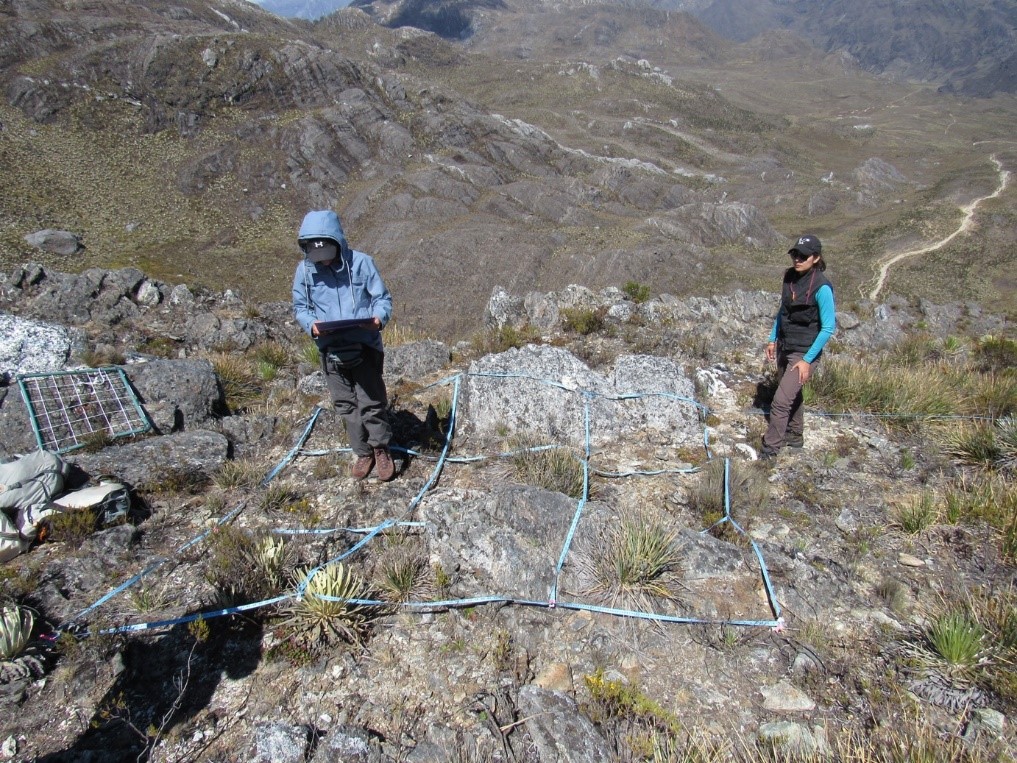Global Observation Research Initiative in Alpine Environments (GLORIA) – Andes Network

Summary
The GLORIA-Andes network is a regional long-term monitoring platform that studies the impacts of climate change on the biodiversity of high mountain ecosystems in the Andes.
It is a consolidated and collaborative South-South cooperation network of Andean research institutions that has been working since 2008 across the Andes, from Venezuela to Chile and southern Argentina. This network provides information based on permanent plots (1m2) quantifiable and standardized data in order to assess the vulnerability of high-Andean ecosystems to global warming. GLORIA-Andes constitutes the South American chapter (https://redgloria.condesan.org/) of the global GLORIA network (https://gloria.ac.at/network/general).
The platform addresses the scarcity of long-term empirical/field-based information on plant-community dynamics and its relationship with soil temperature and substrates using a standardized protocol, which allows effective comparisons at a continental scale. Moreover, being active for more than 10 years, it provides unique long-term records to analyse soil temperature trends on high Andean ecosystems.
The objectives of the network are:
1. To generate medium and long-term quantitative data on plant community dynamics and habitat characteristics in high Andean ecosystems, including soil temperature records, to assess the impact of climate change on the biodiversity of high Andean ecosystems.
2. To promote South-South cooperation of researchers and research centres members of the GLORIA-Andes, and facilitate collaborative work among them at a continental scale to promote the sustainability of the research developed in each of the GLORIA-Andes sites.
3. To systematize and communicate the results of climate change impacts in high mountain ecosystems of the Andes, through the elaboration of validated protocols, monitoring methods, providing logistical, technical and financial support for data collection and information analysis of the climate / biodiversity relationships in Andean monitoring sites.
Overview
- Implementation sites:
-
- Multiple countries
- Multiple locations
- Mountain region:
-
The Northern, Central and Southern Andes, from 6°N to 54°S
- Province:
-
- There are 17 target regions along more than 7000 km in the Andes, from Cordillera de Mérida in Venezuela to Tierra del Fuego in Argentina.
- Site locations:
-
See map of sites at: https://redgloria.condesan.org/
- Solution scale:
- Area Covered:
-
- > 1 million km2
- Ecosystem type(s):
- Solution type(s):
- Sector(s):
- Climate impact(s) addressed:
- Other climate impact(s) addressed:
-
- General temperature increase
- Climate impact time-scale(s):
- Main benefit associated with the solution:
- Co-benefit(s) associated with the solution implementation:
- Implementation timeline:
-
- 2006 - 2100
- Sendai targets:
-
Solution details
Main beneficiaries & outcomes
Key benefits included improved knowledge of climate trends and anomalies, especially long-term changes in superficial soil temperatures at high elevations, where this information is scarce in the Andes. Measured impacts of CC on high elevation ecosystems along the Andes, looking at the impacts on biodiversity/species richness and vegetation composition/structure, changes in surface cover types (e.g. scree, rocks, vascular plants, aboveground necromass, etc.). Risks of species extinctions and/or competitive displacement. This information provides a basis for improved planning of biodiversity conservation strategies in high Andean ecosystems based on empirical assessment of CC related threats to biodiversity and ecosystem vulnerability at a continental scale.
Beneficiaries include researchers and students interested in the dynamics of Andean ecosystems under climate change scenarios; Decision makers, particularly environmental authorities and managers of protected areas (many summits are located within national parks and other protected areas); practitioners, managers of CC mitigation and adaptation strategies and projects; The results derived from monitoring and research of the GLORIA-Andes network are available in 19 publications which include five standardized measurement protocols, two books, three book chapters, seven scientific articles and two dissemination articles. (see https://redgloria.condesan.org/).
Planning and implementation
The network has developed through a cooperative process which has involved the continued support and participation of all the research organizations that are members in the region (16 institutions and 40 researchers). The initial consolidation received support from the Environment Secretariat of the Andean Community (CAN) and CONDESAN (which continues to facilitate regional activities), while the global GLORIA network has also provided key technical support (Austrian Academy of Science).
The Regional Coordination is currently at Universidad de Las Americas (UDLA, Francisco Cuesta, Ecuador) while database management is coordinated at Pontificia Universidad Católica del Ecuador (PUCE, Priscilla Muriel, Ecuador).
Finance
During its operation the network has received support from different institutions including CAN, SDC, GEF, GIZ, CONDESAN, and the PRAA project. Important co-financing comes also from the institutions hosting the Regional Coordination (UDLA, Ecuador) and database management (PUCE, Ecuador). Moreover, the teams responsible for each monitoring site have provided financial and human resources for many of the activities for installation and maintenance in each country.
Innovation
The network comprises the longest long-term vegetation monitoring gradient in South America (along more than 7000 km), from the tropical páramos to the Tierra del Fuego, and it is the only network monitoring climate change impacts on high Andean vegetation.
It records climate data (particularly temperature) at high elevations above the treeline, where this information is particularly scarce.
It is a unique example of South-South cooperation for long-term research. All of its members are research institutions are based in the region.
Performance evaluation
Network actions have been evaluated in the different projects that have offered financial support to the network. This has included indicators linked with the network operation (regional meetings, instalment/maintenance of sites, update/maintenance of databases and herbaria), with it outputs and communication work (publications, webpage updates, impact of communication products) and the participation and promotion of science-policy dialog spaces.
Long term project sustainability and maintenance
There are many lines of work linked with network maintenance:
- Maintenance/replacement of temperature data-loggers and periodic resampling of vegetation in each site (approximately every 5 years).
- Maintenance of herbaria (regional and in each country)
- Maintenance/update of databases and the network webpage
- Annual network meetings
- Production of joint publications
Many of these activities are managed and financed by the institutions responsible for each site. Regional coordination/research activities are currently supported by Universidad de Las Americas (Regional Coordination), PUCE (Database management), CONDESAN and Kew Botanical Gardens. Regional coordination activities are also financed by international projects (currently by the Andean Forest Programme and the Adaptation at Altitude Programme financed by the SDC).
Capacities for design and implementation
Knowledge
The GLORIA protocol was designed and promoted by the Austrian Academy of Sciences, and it has been continuously revised and updated, with the collaboration of scientists in the different regions, including the tropical Andes (e.g. Pauli et al. 2015).
The GLORIA-Andes network has in turn promoted South-South cooperation and capacity building, including the development of several methodological and taxonomic workshops and the generation of scientific publications, synthesis for decision makers and monitoring protocols for complementary research. Many scientist and students in the region have received training and participated in site´s installation and monitoring.
Technology
The network uses up-to-date technology for temperature monitoring using on-site data loggers.
Moreover, GLORIA-Andes has developed and implemented several complementary and innovative monitoring protocols in high mountain ecosystems for aspects such as ecosystem dynamics (carbon stocks and flows) or plant phenology-pollination and climate change experiments (passive warming effects on ecosystem dynamics).
Political / Legal
The establishment of the network received initial support from the Environment Secretariat of the Andean Community – CAN (regional political platform of the Tropical Andean countries).
Institutional
Local partners from each country are the foundation of the GLORIA-Andes network (40 researchers and 16 institutions along the Andes). There is also collaborative work in the different countries between the lead monitoring institutions and national environmental authorities (e.g. National Parks authorities, Ministries of the Environment), including discussions within the framework of several science-policy dialog events. There has been support from regional political platforms such as the Andean Community.
Socio-cultural
Given that the approach of the GLORIA-Andes network is monitoring CC impacts in summit areas with little human impact, the emphasis is not on community based monitoring (it is important to maintain disturbance at the sites to a minimum).
Outlook & Scalability
Barriers and adverse effects
The main barrier for maintaining the network activities in the long-term has been securing permanent and sufficient funding for research activities in each site and for the regional operation of the network (so far funding has come from the local research institutions responsible for each site and from international cooperation agencies such as SDC, GEF, GIZ, etc.).
Although most partner institutions and researchers have shown a remarkable long-term commitment for the maintenance of each site (for over ten years in most cases), there are a few sites that have become inactive because of disengagement of local human resources or lack of funding for resampling activities.
The sustainability and success of the network has been strongly linked with the personal and institutional commitment demonstrated by its members and by the establishment of clear strategies for information management and data sharing and publication. The sustained leadership of the coordinating institutions and researchers has also proved essential.
Transformation and future outlook
The GLORIA-Andes network is providing unique field based empirical data to quantify the impact of CC on high mountain vegetation in the Andes, particularly now that re-sampling campaigns have been carried out in most of the sites. This can help to increase awareness of decision makers and the general public and provides solid information that can be used for the design of conservation and adaptation strategies in the case of high elevation ecosystems. The large inter-annual and spatial variability in climate along the Andes (e.g. precipitation cycles linked to El Niño events) constitutes a major challenge, which can only be overcome by sustaining long-term monitoring efforts across the region. This is the only way to quantify long-term trends and impacts on high Andean biodiversity and to understand how these impacts vary between different ecosystems and ecological contexts (i.e. changes along elevation and latitudinal gradients).
Potential for upscaling and replication
Up-scaling has been an essential component of the growth of the GLORIA-Andes network over the years, with the incorporation of new partners and sites. Recently three monitoring sites have joined the network (two in Patagonia and one in Chile). However, there are regions across the Andes were more sites are required to provide a more comprehensive view of continental scale patterns and dynamics (e.g. new sites in Colombia, central Peru, etc.). To continue strengthening the links with national monitoring institutions and programmes and regional political platforms is a key component for the long-term sustainability of the network as well.




Comments
There is no content